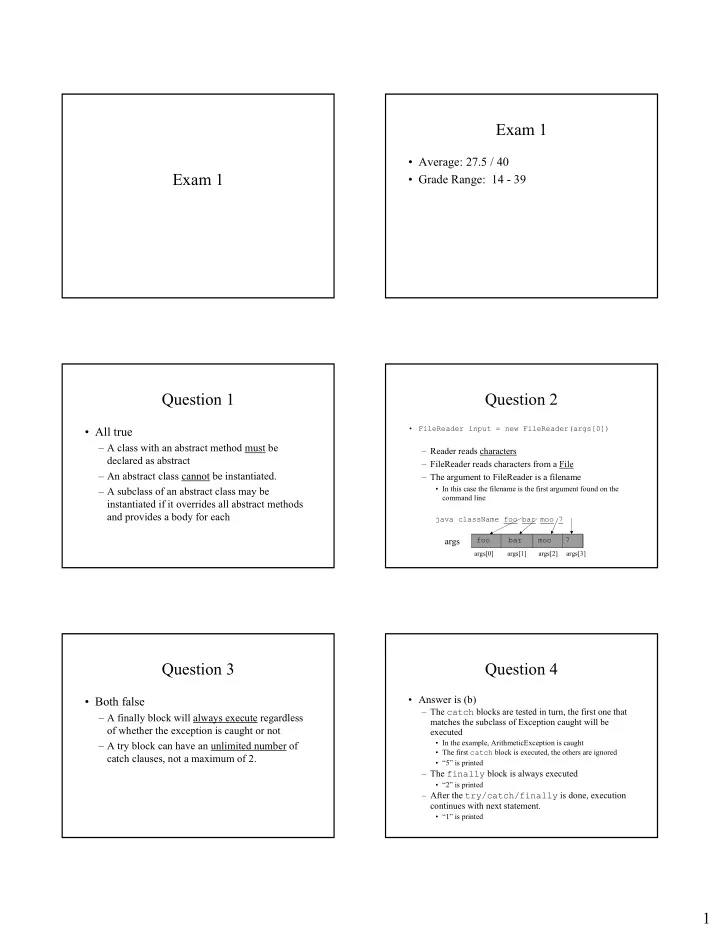

Exam 1 • Average: 27.5 / 40 Exam 1 • Grade Range: 14 - 39 Question 1 Question 2 • FileReader input = new FileReader(args[0]) • All true – A class with an abstract method must be – Reader reads characters declared as abstract – FileReader reads characters from a File – An abstract class cannot be instantiated. – The argument to FileReader is a filename • In this case the filename is the first argument found on the – A subclass of an abstract class may be command line instantiated if it overrides all abstract methods and provides a body for each java className foo bar moo 7 args foo bar moo 7 args[0] args[1] args[2] args[3] Question 3 Question 4 • Answer is (b) • Both false – The catch blocks are tested in turn, the first one that – A finally block will always execute regardless matches the subclass of Exception caught will be of whether the exception is caught or not executed • In the example, ArithmeticException is caught – A try block can have an unlimited number of • The first catch block is executed, the others are ignored catch clauses, not a maximum of 2. • “5” is printed – The finally block is always executed • “2” is printed – After the try/catch/finally is done, execution continues with next statement. • “1” is printed 1
Question 5 Question 5 • Answer is (a) • Code will compile – C.max overrides B.max which overrides A.max A max(int x, int y) • This is good subclass behavior and is okay – Switching the arguments in B.max is okay since both arguments are ints B max(int x, int y) • May not run as expected but it will pass the compiler C max(int x, int y) Question 5 Question 5 • Let’s step through code • Let’s step through code – C c = new C(); – In B.max(23, 39) • return super.max (y, x) – 10; – c.max (13, 29); • call A.max (39, 23) • A.max (39, 23) will return 39 – In C.max(13, 29): • B.max(23, 39) will return 39 – 10 = 29 • return (super.max (x + 10, y + 10) • C.max(13, 29) returns 29 • “29” gets printed • Call B.max (23, 39) Question 6 Question 6 • In main • Answer is (c) – A ref1 = new C(); // okay since C is subclass of B A int f() { return 0;} // which is a subclass of A – B ref2 = (B)ref1; // Cast ok since C is subclass of B – print ref2.f(); – Ref2 is referencing an object of type C B int f() { return 1;} • Even though it is declared as class B – This is okay – Polymorphism • C.f() is called. C int f() { return 2;} • “2” is printed. 2
Question 7 Question 7 • In main Mother identify() – Mother m = new Daughter(); – Daughter d = new Daughter(); – m.identify(); – d.identify(); Daughter identify() – Both m and d reference objects of type Daughter • This is okay since Daughter is a subclass of Mother • Polymorphism • Daughter.identify is called in both cases – Output • This is a Daughter speaking • This is a Daughter speaking Question 8 Question 9 • Could be interpreted as what happens • To get data from the keyboard during compile time or runtime: – You read from System.in – Compile time: – Gave 1 point if you gave correct instantiation of • Will cause compile error some InputStream. • Why: exception not caught and not declared • new FileInputStream(…) • Recall: – If method A calls method B and method B throws an exception, A can either: » Catch it » Declare that it can throw the same kind of Exception. Question 9 Question 10 • Could be interpreted as what happens • Reader/Writer during compile time or runtime: – Reads and writes characters – Runtime: • InputStream/OutputStream • Exception will be passed to the one who called the – Reads and writes bytes method • Passing up will continue until main is reached at which point the program will terminate. 3
Question 11 Question 11 • Alternately, since Auto data is protected • Truck Class: class Truck extends Auto { class Truck extends Auto { private int towingWeight; private int towingWeight; public Truck (int year, int doors, int weight){ public Truck (int year, int doors, int weight){ super.year= year; super (year, doors); // must be first super.doors = doors; towingWeight = weight; towingWeight = weight; } } public String report () { public String report () { return (“Vehicle is a “ + getYear() + “ Truck return (“Vehicle is a “ + year + “ Truck “); “); } } } } Question 12 Question 13 • BufferedWriter output = new BufferedWriter ( • We subclass Exceptions new OutputStreamWriter ( – So that we can distinguish a specific exception new FileOutputStream (“myTest”))) condition -- Program writes character data (BufferedWriter) – Method catching exceptions can take different -- This data is buffered for eficiency (BufferedWriter) actions based on type of exception. -- Converted to bytes (OutputStreamWriter) -- written to file “myTest” (FileOutputStream) Question 14 Exam • The program will not compile • Any questions? – try block without a corresponding catch – The fact that f is private is okay • Since main is a method of X7, it can access its private members. 4
Recommend
More recommend